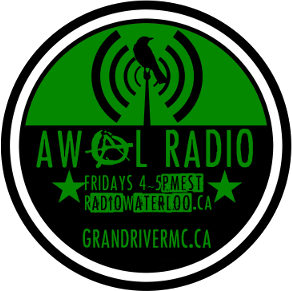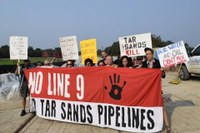Enbridge Line 9 Work Disrupted as Demonstrators Demand an End to Tar Sands, Fracking
September 2, 2015 Port Hope -- Opponents of Enbridge's Line 9 Tar Sands and fracking pipeline
are in Port Hope at the site of testing operations of the controversial
pipeline. Enbridge is conducting newly mandated hydrostatic testing on
three segments of the 40-year-old pipeline before the company can be
permitted to pump bitumen through it. Activists maintain that this testing
in no way mitigates Line 9's impacts.
“Running water through a few spots in this aging pipeline doesn't mean it
won't break, and moveover it does nothing to address the devastation
wrought by the tar sands and fracking fields,” says demonstrator Niloofar
Gol. “We are opposed to Enbridge's Line 9 project because it facilitates
tar sands and fracking expansion, which is poisoning Indigenous
communities, damaging ecosystems and contributing to catastrophic climate
change.”
The hydrostatic tests were ordered by the National Energy Board in June
2015 as a further requirement beyond the initially mandated conditions. The
Board acknowledged the impact of public concern stating in their press
release that “a higher degree of confidence in the integrity, or condition,
of the pipeline is required.” The order came after residents' groups and
municipalities including the Greater Montreal Area demanded such testing.
However, even these groups are unsatisfied with the limited scope and
lower-than-standard pressure at which Enbridge is testing the line. Those
disrupting the testing today are not prepared to give the Line 9 project a
thumbs-up even if it passes the testing. As demonstrator Rachel Avery
emphasises, “It's not just a 'safety' issue for leaks along the line, it's
not just 'no bitumen spill in my backyard.' It's about leaving it in the
ground and putting a halt to the disastrous impacts of tar sands and
fracking extraction.”
Line 9 is one of many planned tar sands pipeline projects including
Enbridge's Northern Gateway and TransCanada's Energy East which also face
stern opposition from Indigenous and settler communities. Line 9 is
currently facing a legal challenge from Chippewas of the Thames First
Nation on the basis that they were not consulted, as is their right as an
Indigenous community in the pipeline's path. A decision on their challenge
is expected this fall.
Today's demonstration is one of many efforts against tar sands taking place
across the country this week. In Unist'ot'en territory on the west coast,
Indigenous land defenders and supporters are maintaining their blockade
against pipeline construction in the face of mounting RCMP presence. In
Aamjiwnaang, an Anishinaabe community near Sarnia, a “Toxic Tour” is being
held on Saturday to call attention to the impacts of the concentration of
petrochemical industry surrounding the reserve. The tour is expected to
draw hundreds of people from across the province.


